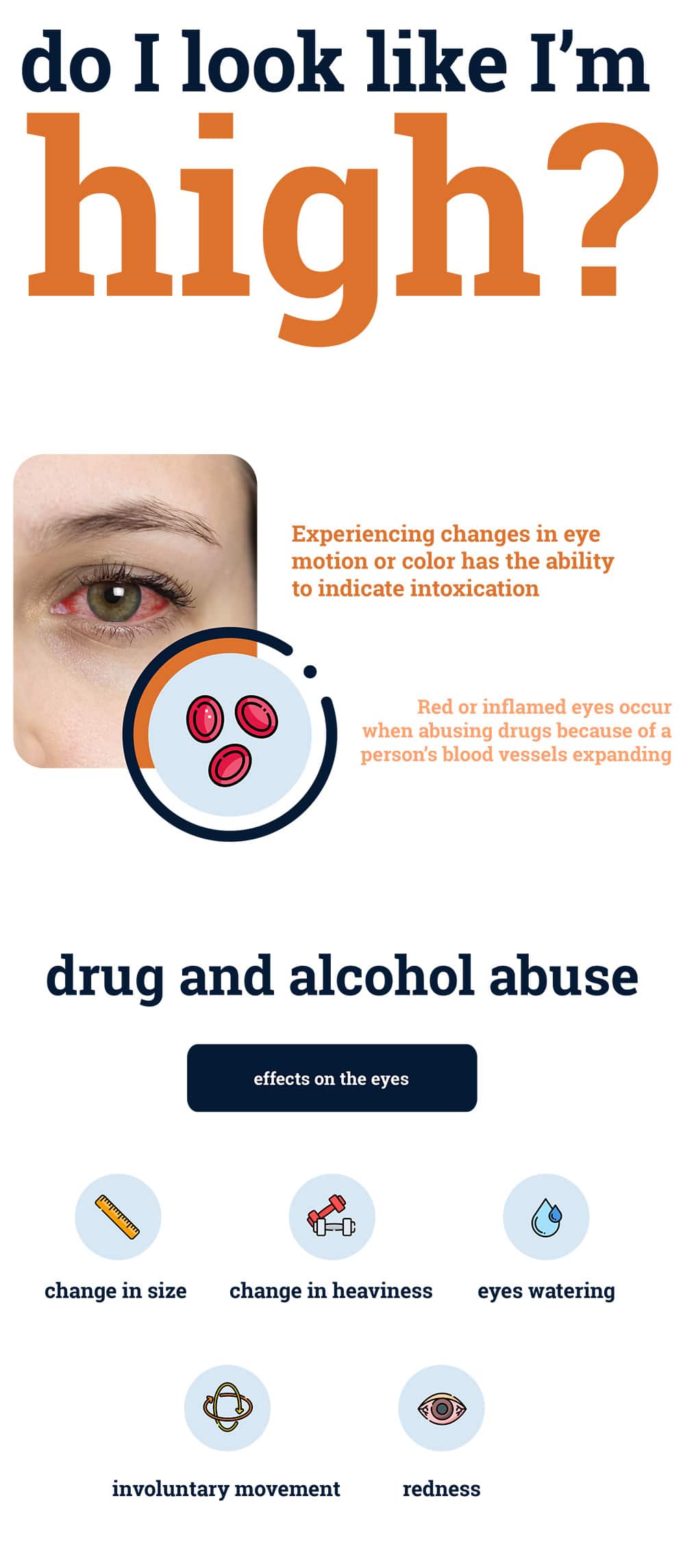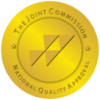Drug and alcohol abuse can cause numerous side effects such as the following:
- Loss of coordination
- Mood changes
- Aggression
- Sleepiness
- Nausea
 All of the following is able to indicate intoxication. When the above-mentioned are frequently recognized in an individual, along with many other health consequences such as teeth, skin, mental health, social habits, and hair, they can further indicate problematic substance use. As a person experiences changes in the eye, motion, color of the whites, and pupil size, all of these factors can be utilized to fully assess whether a person is intoxicated or not.
All of the following is able to indicate intoxication. When the above-mentioned are frequently recognized in an individual, along with many other health consequences such as teeth, skin, mental health, social habits, and hair, they can further indicate problematic substance use. As a person experiences changes in the eye, motion, color of the whites, and pupil size, all of these factors can be utilized to fully assess whether a person is intoxicated or not.
Experiencing changes in an individual’s eye’s general motion or color has the ability to indicate intoxication. Based on our collective patient’s data and experiences at our addiction treatment center Illinois, one of the most common symptoms of intoxication from numerous drugs, especially cocaine, marijuana, and alcohol occurs because of a person’s blood vessels expanding. There are numerous other drugs that causes the following in eyes:
- Changes in size
- Heaviness
- Watering
The above-mentioned signs are known as pinpointed pupils. Pinpoint pupils are commonly caused by substance use, including opioids (heroin, fentanyl) and benzodiazepines. Narcotics like heroin, hydrocodone, morphine, and fentanyl also constrict pupils, leading to pinpoint pupils in high doses. PCP (phencyclidine) may also affect the eyes, causing rapid, involuntary movements.
Common signs of intoxication indicated by the eyes include the following:
- Rapid or nystagmus involuntary movements of the eyeballs
- Either dilated or constricted changes in the pupil size
- Bloodshot eye or conjunctival redness
Jump to Section
Your Pupils on Drugs: Specific Substances
People’s pupils on drugs may be different depending on each particular substance. Almost every substance of abuse can cause eye changes on eyes on drugs. Below are the specific changes in eye motion, pupils, or vision that are able to indicate overdose or intoxication from specific substances.
Alcohol
Alcohol intoxication can cause blurry vision or double vision.
Amphetamines
Molly, MDMA, Ecstasy, and similar drugs can cause pupil size changes and blurred vision. These drugs can also cause nystagmus. Nystagmus is a rapid quivering of an individual’s pupils, indicating eyes on drugs.
Benzodiazepines
Similar to alcohol, benzodiazepines at recreational doses can cause altered blurry or double vision. Remember that dilated pupils are a sign of overdose.
Cigarettes
In general, smoking cigarettes, in particular, can lead to cataracts of the crystalline lens. This is an area of an individual’s eye that produces one-third of the image the person’s brain processes by focusing light onto the retina.
Crack Cocaine and Cocaine
As cocaine is able to stimulate an individual’s brain and release adrenaline and endorphins, the body will, in turn, react by dilating the pupils. The biggest symptom of overdose includes hallucinations. Especially visual hallucinations.
Dextromethorphan
Dextromethorphan is a common cough-suppressing ingredient in flu and cold medicines. This substance has the potential of causing intoxication. One of the main symptoms of Dextromethorphan, also known as DXM is nystagmus. As mentioned, nystagmus is rapid, involuntary eye movements.
GHB
GHB is a depressant sometimes called liquid ecstasy. It can be abused by putting the drug into a person’s eyes using eye drops. However, it’s most commonly used by being mixed into a drink and consumed orally. GHB is also known to cause hallucinations. Therefore causing eyes on drugs.
Hallucinogens
LSD, Mescaline, and other similar drugs cause an individual’s pupils to dilate. This is how you know their pupils on drugs are occurring. The individual engaging in hallucinogens will most likely undergo visual hallucinations.
Heroin
This narcotic is able to cause drooping eyelids in an individual due to sleepiness. Heroin will also cause a person’s pupils to constrict. Once this process occurs, it leads to pinpointed pupils.
Inhalants
When an individual begins abusing substances such as nitrous in canisters and paint thinner, it can lead to red, watering eyes. This is a sign of intoxication. Take this as a sign the person’s eyes on drugs.
Ketamine
Involuntary and rapid dilated pupils and eye movement are symptoms of intoxication from this narcotic-like drug. Similar to alcohol, ketamine can also cause visual impairment.
Marijuana
The most common side effect of marijuana is bloodshot eyes. Also known as eyes on drugs.
Methamphetamine
One of the main symptoms of methamphetamine intoxication is rapid eye movements. These rapid eye movements are typically about ten times faster than average eye movements.
Narcotics
Both illicit and legal narcotic drugs, including Hydrocodone, Morphine, Fentanyl, and Heroin constrict an individual’s pupils. At higher doses, one of the main symptoms of Narcotics is pinpoint pupils that don’t respond to light changes.
Phencyclidine (PCP)
This drug causes involuntary rapid eye movements. An individual on PCP might also develop a blank stare. When this occurs, they won’t respond to direct visual stimuli.
Poppers
Poppers are able to cause irreversible vision loss. This can occur potentially due to brain damage, but it also can occur due to maculopathy.

Can Long-Term Drug or Alcohol Abuse Cause Damage to Your Vision?
Long-term drug or alcohol abuse can cause damage to your vision, leaving pupils on drugs to become the norm. When an individual struggle with substance abuse addiction for an extended period of time, they’re more likely to struggle with serious health issues. A few of the frequently reported health consequences relating to drug abuse are the following:
- Ulcers in the stomach and small intestine
- Blood pressure problems
- Liver and kidney damage
- Heart damage
- Diabetes
- Cancer
Substance abuse is directly correlated to long-term issues with vision due to the damage of the ocular nerve, the eyes, and brain. Listed below are long-term matters of the eyes caused by the relationship between drug addiction and abuse.
Corneas Damage
Keratitis is the inflammation of the corneas, which is also able to distort vision. Topical anesthetics, cocaine, and crack cocaine can all cause this type of inflammation. When there is long-term abuse occurring causing constant keratitis, this can lead to infectious ulcers in the corneal perforation and corneas.
Age-Related Macular Degeneration
This type of vision loss can occur in individuals over the age of 50 regardless of their long-term health. However, it’s most likely to happen and can be worsened due to substance abuse—especially the abuse of tobacco and alcohol.
Endophthalmitis
Endophthalmitis is inflammation inside the eyes caused by infection. Sometimes this condition is associated with injecting drugs by way of dirty needles. These dirty needles can cause infections to spread all throughout your body.
Dry Eye Syndrome
Problems forming tears, persistent dry eyes, and feeling as though your eyes are irritated, are issues that can develop due to an individual engaging in heavy alcohol consumption. Even though the above-mentioned aren’t directly related to current intoxication of alcohol.
Hallucinogen Persisting Perception Disorder (HPPD)
HPPD is often called flashabacks. This condition involves repeated but sudden reoccurrences of some of the sensory changes experienced during LSD use. The above-mentioned includes distortions in the peripheral vision and seeing things that aren’t actually there. HPPD is the most common with LSD. It is not associated with organic hallucinogens like Psilocybin.
Glaucoma
Long-term increases in intraocular pressure and blood pressure changes that alter the fluid pressure in an individual’s eye itself can all lead to glaucoma. Alcohol use disorder is one of the common factors in substance-induced glaucoma.
Maculopathy
Maculopathy is the degeneration of the retina. It is generally related to age, but it’s also caused by substance abuse in a few cases. The central part of an individual’s vision becomes distorted and blurry.
This type of condition often rapidly worsens because the brain and eye will compensate for the loss of vision, especially in the early stages. Cocaine, poppers, and other drugs that are snorted are related to maculopathy.
Lesions
Drugs that come as eye drops are able to cause damage to the whites of the eyes and the conjunctiva. Long-term damage to the eyes can cause noncancerous lesions.
Eye Movement Persistent Changes
Nystagmus, or rapid eye motion is a symptom of intoxication on a variety of different drugs. If changes in the eye movements do not go away after the individual has detoxed from the substance, it could indicate brain damage that has changed how the brain processes visual stimuli.
Ocular Bone Damage
When an individual snorts drugs, it can lead to damaging the tissues around the sinuses to the point of degeneration. Most often than not, this will appear as extreme damage of the tissues between nostrils, also known as septal perforation. Tissue damage can continue into small bones around the sinuses and the upper plate, including the ocular ridge bones.
Talc Retinopathy
Talc retinopathy is the buildup of yellowish or white crystalline particles in the vascular areas of the eye. This has been associated with some intranasal and intravenous drug abuse.
Retinal Vascular Occlusive Disease (RVOD)
RVOD is caused by changes in an individual’s blood pressure or a blood clot, which prevents healthy blood flow to and from the eye. Bleeding, swelling, and abnormal blood vessel growth in the retina can eventually cause total or partial vision loss. RVOD is related to the following:
- Inflammatory conditions
- High blood pressure
- Blood clotting
- Cholesterol
- Glaucoma
- Diabetes
All of the above-mentioned items can develop due to past substance abuse. In addition, smoking is a direct cause of RVOD.
Wernicke’s Encephalopathy
Wernicke’s Encephalopathy is sometimes caused by long-term excessive alcohol consumption. It’s been associated with disc edema, which causes nerve death in the cluster connecting the eye to the individual’s brain and optic neuropathy.
Yellowed Eyes
Intoxicating substances such as opioids, steroids, stimulants, and alcohol can damage a person’s liver, leading to cirrhosis, which in turn can cause jaundice. Jaundice is yellowing of the skin and whites of the eyes. Hepatitis C, which is able to be contacted by the sharing of needles during drug use, can cause jaundice and liver failure.
Toxic Cataracts
When a person engages in long-term substance use, it can lead to the development of cataracts due to fatal effects the substance can have on an individual’s body.
Put a Cease to Eye Damage by Conquering Substance Abuse




Licensed Physician and Surgeon
Dr. Beth Dunlap, a board-certified addiction medicine and family medicine physician, and is the medical director at Northern Illinois Recovery Center. She is responsible for overseeing all the integrated medical services at both campuses. Beth completed medical school, residency, and fellowship at Northwestern University, where she continues to serve on the faculty as a member of the Department of Family and Community Medicine. She has extensive experience in addiction medicine at all levels of care, and her clinical interests include integrated primary care and addiction medicine, harm reduction, and medication-assisted treatment.



